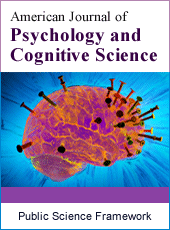American Journal of Psychology and Cognitive Science
Articles Information
American Journal of Psychology and Cognitive Science, Vol.4, No.1, Mar. 2018, Pub. Date: Jun. 6, 2018
Parallelism Effects in Chinese Coordinate Structure: Evidence from Eye Movement Study
Pages: 8-16 Views: 2193 Downloads: 1274
[01]
Tao Zeng, College of Foreign Languages, Hunan University, Changsha, China.
[02]
Taoyan Zhu, College of Foreign Languages, Hunan University, Changsha, China.
[03]
Zhang Min, College of Foreign Languages, Hunan University, Changsha, China.
[04]
Xiaoya Li, College of Foreign Languages, Hunan University, Changsha, China.
When reading two phrases or clauses with the same structures, the second constituent of the parallel structure is processed faster when it parallels the first constituent, this phenomenon is named as parallelism effects. In English, parallelism effect occurs in coordinate structure which is also a common type of phrase structure in Chinese, so this effect also happens in processing Chinese coordinate structure. In Chinese, several coordinate phrase structures coexist such as coordinate structure with conjunction “HE”(and) or Chinese punctuation marker (、), as well as label free coordinate structure. In the present study, a single factor and two-level experimental design was carried out to explore the parallelism effects of different coordinate phrase structures in Chinese. By adopting eye tracker, the experiment involved 41 Chinese native coming from different schools of Hunan University. Results showed that: 1) There were parallelism effects in coordinate structures with “HE” and Chinese punctuation marker (、), while the parallelism effect in processing of label free coordinate structure is not obvious. 2) There were significant differences in eye movement among these three Chinese coordinate structures during reading process. 3) The parallelism effect in Chinese coordinate structure is a special form of syntactic prediction, and it is not the result of syntactic priming.
Parallelism Effects, Coordinate Structure, Syntactic Prediction, Eye Tracking
[01]
Apel, J., Knoeferle, P., &Crocker, M. W. 2007. Processing parallel structure: Evidence from eyetracking and a computational model [C]. London: Taylor & Francis: 125-131.
[02]
Bai Xuejun, Li Xin & Yan Guoli. 2015. Eye movement control in Chinese Reading: A summary over the past 20years of Research [J]. Psychological Development and Education 31 (1): 85-91.
[03]
Crocker, M. 2009. Constituent order and semantic parallelism in online comprehension: eye-tracking evidence from German [J]. Quarterly Journal of Experimental Psychology 62 (12): 2338-231.
[04]
Dubey, A., Keller, F., & Sturt P. 2008. A probabilistic corpus-based model of syntactic parallelism [J]. Cognition 109 (3): 326-344.
[05]
Dubey, A., Sturt, P.,& Keller, F. 2005. Parallelism in coordination as an instance of syntacticpriming: Evidence from corpus-based modeling [C]. Association for Computational Linguistics: 827-834.
[06]
Duffield, N., Matsuo, A., Roberts, L. 2009. Factoring out the parallelism effect in VP-ellipsis: English vs. Dutch contrasts [J]. Second Language Research 25 (4): 427-467.
[07]
Frank, M. 2010. Syntactic priming in comprehension: parallelism effects with and withoutcoordination [J]. Journal of Memory and Language 62: 333-351.
[08]
Frazier, L., Taft, L., Roeper, T., Clifton, C., & Ehrlich, K. 1984. Parallel structure: A source offacilitation in sentence comprehension [J] Memory and Cognition 12 (5): 421–430.
[09]
Frazier, L., Munn, A., &Clifton, C. 2000. Processing coordinate structures [J]. Journal of Psycholinguistic Research 29 (4): 343-370.
[10]
Li Ying. 2014. The parallelism effect in Chinese sentence comprehension [D]. Liaoing: LiaoningNormal University.
[11]
Mehler, J., &Carey, P. 1968. The interaction of veracity and syntax in the processing of sentences [J]. Perception & Psychophysics 3 (2): 109-111.
[12]
Pickering, M. J., & Branigan, H. P. 1999. Syntactic priming in language production [J]. Trends incognitive sciences 3 (4): 136-141.
[13]
Pickering, M. J., &Ferreira, V. S. 2008. Structural priming: a critical review [J]. Psychologicalbulletin 134 (3): 427.
[14]
Prokopenya, V., & Chernigovskaya, T. 2017. Grammatical parallelism effect in anaphora resolution: Using data fromRussian to choose between theoretical approaches [J]. International Journal of Cognitive Research in Science Engineering & Education. 5 (1): 85-95.
[15]
Sauermann, A., & Gagarina, N. 2017. Grammatical role parallelism influences Ambiguous pronoun resolution inGerman [J]. Frontiers in Psychology 8: 1205.
[16]
Scherre, M. M. P. 2001. Phrase-level parallelism effect on noun phrase number agreement [J]. Language Variation and Change 13 (1): 91-107.
[17]
Staub, A., & Clifton, C. Jr. 2006. Syntactic prediction in language comprehension: evidence from either... or [J]. Journal of experimental psychology: Learning, memory, and cognition 32 (2): 425.
[18]
Sturt, P., Keller, F., & Dubey, A. 2010. Syntactic priming in comprehension: parallelism effects with and without coordination [J]. Journal of Memory and Language 62: 333-351.
[19]
Wu Kun. 2016. Research on coordination structure according to Transformational Grammar [J]. LiteratureEducation 9: 44-46.
[20]
Wu Yunfang. 2014. V+V: the coordinate structure [J]. Studies in Language and Linguistics 24 (3): 45-51.
[21]
Yan Guoli, XiongJianping, Zang Chuanli, Yu Lili, Cui Lei & Bai Xuejun. 2013. Review ofeye-movement measures in reading research [J]. Advances in Psychological Science 21 (4): 589-605.
[22]
Yang Mengmeng& Hu Jianhua. 2017. A review of «Coordination in Syntax» [J]. Contemporary Linguistics 19 (2): 272-279.
[23]
Yang Mengmeng & Hu Jianhua. 2017. Strategies of coordination from a cross-linguistic perspective [J]. Foreign Language and Research 49 (5): 719-800.

ISSN Print: 2381-7453
ISSN Online: 2381-747X
Current Issue:
Vol. 6, Issue 2, June Submit a Manuscript Join Editorial Board Join Reviewer Team
ISSN Online: 2381-747X
Current Issue:
Vol. 6, Issue 2, June Submit a Manuscript Join Editorial Board Join Reviewer Team
| About This Journal |
| All Issues |
| Open Access |
| Indexing |
| Payment Information |
| Author Guidelines |
| Review Process |
| Publication Ethics |
| Editorial Board |
| Peer Reviewers |


